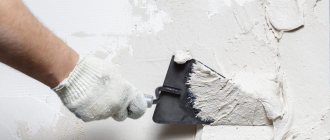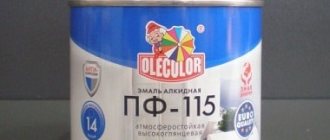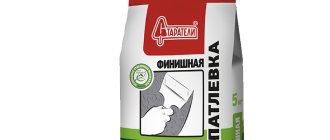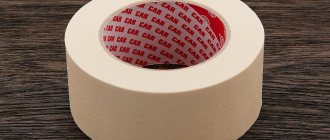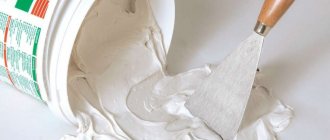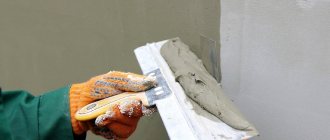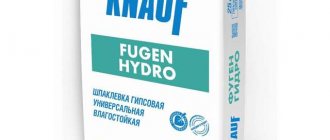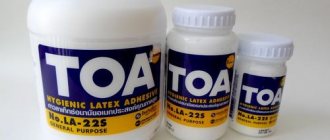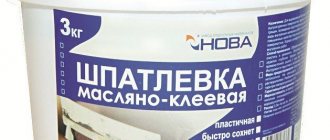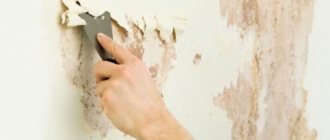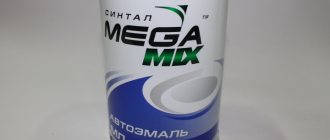Puttying the surface helps to obtain a base for any type of finishing materials; after using this building material, the walls acquire the necessary evenness and strength. A popular type among putty mixtures is cement-based. It has a number of positive aspects. Cement putty, what makes it remarkable will be discussed below.
Types of cement putty
Since cement-based putty is quite widespread, manufacturers of building materials divide the products produced in this segment into the following types:
- Facade. Used for exterior finishing work.
- Thermal insulation. This putty is used for thermal insulation work in combination with other insulation products.
- For interior work. Accordingly, it is successfully used for interior decoration.
In terms of their structure, cement putties consist of cement, as well as polymer additives and mineral fillers. This composition makes the consistency of the putty convenient for work, and the finished surface is perfectly smooth and has a high degree of strength.
Accordingly, depending on the composition and purpose, cement putties are divided into 2 types:
Starting. It has a coarse-grained structure and can be used to hide significant unevenness, seal cracks or crevices on walls and other surfaces. It contains quartz sand, therefore, cement putty for initial treatment can be applied in a layer of up to 2 centimeters - you must agree, such a thickness will certainly mask almost any imperfections without loss of properties.
Finish. It also contains sand, but of a very fine fraction, which will not allow it to be applied in a thick layer. Yes, this is not necessary, the finishing mixture is necessary for finishing the surfaces to the smoothest possible state; it does not cover up unevenness.
It largely depends on what kind of cement was used to make the putty: it will have a gray or white tint. White mixtures are made from white cement, the cost of which is much more expensive than usual. Putty on the simplest, gray cement, looks similar in appearance to light cement mortar.
In what form can you buy cement putty?
Another classification of cement putties is directly based on the sales format of the product. Here, like many other analogues, there are only two options:
- Dry putty mixture
This putty is sold in bags or bags, depending on the amount of material. Its convenience is that you can buy a large volume much cheaper than ready-made putty, and also: you can mix as much product as you need. Also, it is the dry mixture that can be diluted to the ideal consistency - for each master it can be different, which is easier for him to work with.
- Ready-to-use putty
It is sold already mixed, in a “wet” form, packaged in plastic buckets of various weight categories - but not more than 5-6 kg. Of course, such a product is convenient to use because you simply open the lid of the bucket and you can start working, but on the other hand, such a mixture dries out faster and cannot be used again. Also, “wet” cement putty cannot be applied thickly in one layer, because it shrinks and in this case, cracks will form after drying. In general, this format of putty is best suited if there is a need to seal small cracks and the surface to be treated is not too large.
Where are they used?
Cement putty is considered universal; it is suitable for work inside and outside the building. Despite its good technical characteristics, which provide reliable protection on the surface from natural factors, the composition is safe, so it can be safely used for indoor work.
The same properties allow you to choose a composition for rooms with a dry microclimate and a humid one. A bathroom, toilet, or kitchen can be covered with a putty composition; moisture will not destroy the coating.
If we talk about the base on which it is better to apply it, then we note concrete, brick and plaster layer.
Cement putty is considered universal; it is suitable for work inside and outside the building.
Pros and cons of cement putties
Like any finishing material, cement putties have their advantages and disadvantages. To successfully use this putty, it will be enough to know about them and apply the product accordingly to avoid trouble.
Pros:
- Easy to use. Cement putty, properly prepared from a dry mixture or already purchased ready-made, has a soft consistency and is easy to apply. Even an amateur in finishing work can work with it, not to mention those who have experience of this kind.
- Strength of cement. Cement, from which the putty is actually made, is one of the most durable and strong materials for sealing cracks and irregularities. The finishing layer obtained after drying will last unchanged for many years. It is well suited for uneven surfaces, as it can level out large differences - up to 15 millimeters it is quite capable.
- Cement putties are not afraid of frost, heat, and moisture. They are suitable for rooms without heating, bathrooms, kitchens, garages and at the same time, bedrooms and living rooms.
- Price. The cost of cement putties, along with their reliability, also guarantees their popularity in the finishing materials market. Since the main ingredient - cement - is not expensive, the putty itself is quite affordable for everyone.
The advantages are quite significant, which is why cement putties are mass produced and also purchased in large quantities.
Minuses:
Large granular structure. Even finishing putty made on a cement base has some graininess - this is due to the properties of its main component - cement, as well as quartz additives. That is, even the most expensive and high-quality cement putty will not leave behind that ideal smoothness that, for example, gypsum putty can provide.
There is no ideal whiteness. Even those putties that are made with white cement have a yellowish tint after drying. This finish is not suitable for painting, but if you plan to wallpaper the room, then in this case the shade is not a hindrance.
An important nuance: cement putties cannot be mixed with dyes, varnish, adhesives or anything else. If something accidentally gets into the finished mixture, it is unsuitable for use.
How to calculate the required quantity
To understand how many bags of mixture or buckets of solution you should purchase to finish the entire surface, you need to calculate the consumption in advance. First, the total area that will be processed is calculated. To do this, measure the length and width of each wall, as well as the sizes of windows and doors in the room; their area will need to be subtracted from the total area.
The average consumption rate is written on the label by the manufacturer. However, it is worth understanding that only ideal working conditions and a thickness of 1 millimeter are taken into account. The indicator may be affected by the following indicators:
- The preparedness of the surface before puttying, what irregularities will have to be repaired;
- Application area outside or inside the building.
The area is multiplied by the flow rate, layer thickness and number of layers. The standard consumption of cement compositions is 1-1.6 kg/sq.m. m. surface.
First, the total area that will be processed is calculated.
Making putty from dry powder?
Since this particular format of cement putties is most in demand, before starting work, you need to take care of obtaining the correct mixture, ready for work. The algorithm is not complicated:
1) Fill a bucket or basin one third full with clean water. For cooking, you need to use only plastic containers - a bucket, a basin. Fill the container one third with clean water at room temperature.
2) Apply dry putty. In terms of quantity, try to roughly follow the manufacturer’s instructions on the packaging, but they are not always accurate.
3) Stir the mixture. Mix well, for example with a spatula, trowel or small spatula. After the mixture has become homogeneous, you need to beat it thoroughly with a construction mixer or using a special attachment - a mixer for a hammer drill.
In general, the putty is ready, but before starting work, check that the consistency is correct: when applying the product to the spatula, it should not flow from it. If the consistency is liquid, add a little dry putty; if it is too thick and sandy, then, on the contrary, you need to add water. If there are lumps, the mixture is not mixed well enough and you need to continue this process.
Important: the finished cement putty dries in approximately one to two hours, depending on the volume. Therefore, when planning finishing work, try not to mix a lot of product at once; it is better to prepare the next portion if necessary. When mixing for the first time, make a note of the proportions of water and dry powder you used - this will help you prepare subsequent portions of putty with exactly the same consistency.
Possible effects
Every molar is capable of decorating walls with putty. To do this, you need to be able to prepare a solution of the correct consistency. It should look like thick sour cream without lumps. Since the composition tends to dry quickly, it cannot be prepared in large quantities. It is better to mix the powder with water with a mixer turned on at low power. It is important to comply with all the manufacturer’s requirements and take the recommended mixture to water ratio, as well as follow the suggested sequence of adding components. Only under such conditions can one expect that the ready-to-use material will “work correctly.”
Experienced molars prefer to use warm water to mix the solution. This way the powder dissolves better. You need to prepare the putty when you already have all the tools necessary for the job at hand (large and small spatula, metal brush, roller with a shaped roller, cloth or rags).
Different tools will help you create different reliefs on fresh plaster Source delaisteny.ru
Decorative puttying of walls begins in the same way as regular leveling:
- The surface is first cleaned of contaminants: old paint is removed, oil stains are cleaned with a solvent, cement laitance is cleaned with a spatula.
- Smooth areas are given a roughness: with a spatula, notches or grooves are made on them, which can provide the required percentage of adhesion of the new layer to the old base.
- The walls are primed with a suitable primer (if the surface is porous, it is worth applying the primer in two layers).
- To prevent the base from drawing water out of the putty later, it is moistened before applying the mixture. If this is not done, applying the solution to a dry surface will be extremely difficult. It will clump, which will have a negative effect on the even distribution of the putty.
- Apply the putty with a spatula in a sweeping motion in one direction. It is important to maintain the correct angle between the tool and the wall. If you need to create some additional pattern on the surface, the technology of applying decorative plaster from ordinary putty is used.
The “rain” effect created on the wall using decorative plaster Source firebioprotection.com
See also: Catalog of projects of houses with an attic and a garage in the chalet style.
So, for example, to get a “rain” texture, the mixture must be applied at an angle from bottom to top or horizontally from one edge of the wall to the other. This will be the second layer of putty. It lies on the first one after it dries well. When the second layer has set slightly, you need to sand it, leaving a trace of an intermittent furrow. At the final stage, the wall must be painted. The paint will only apply to the protruding part of the finish; deep unevenness will remain unpainted. This will help create the desired decorative effect.
To obtain the “brush” texture, you do not need to wait for the applied layer to partially dry. Immediately take a metal brush and use it to create furrows in the desired direction. You can move it horizontally, vertically, wavy, in circles. By adjusting the depth of movements, you can create different decorative effects.
Wave effect created using a brush Source 72pd.ru
To obtain the “scale” texture, the putty is applied in pieces with a small spatula. A new stroke is applied on top of the previous one, without waiting for it to dry. In order for the curls to obtain the desired shape, the spatula lingers on the surface of the wall for a few seconds, and only then is pulled away from the base. When the putty applied in this way dries, a pattern is created that has depth and volume.
The scales are formed with a spatula Source yarstroyservis.ru
Beautiful wall decor with putty is obtained using polyethylene. If you apply it to the newly applied layer of leveling mixture and leave it for a day, then after removing the film you will get a surface that imitates the walls of a cave. This effect helps create an interesting interior design.
A professional craftsman can use putty to create a wall that looks like a rock. To do this, he unevenly distributes the solution in one small area (50x50 cm). Then a thicker layer of solution is applied to the next area. Use a smoothing iron to smooth out protruding edges and form natural streaks. It turns out very beautiful, as evidenced by the following photo.
Decorative putty “Rock” Source antiseptic.kiev.ua
See also: Catalog of companies that specialize in finishing materials and glass products.
You can create decor from putty using a figured roller and a piece of rag. Tools are applied immediately, while the leveler layer has not yet dried. To create unusual effects, any available materials are suitable (dishwashing sponge, tree branches, leaves and flowers from the herbarium). You need to experiment and try to create something original on a small piece of wall, and then evaluate the results. If you like them, it will be much easier to see what the finish will look like when finished.
Work with putty
Cement putty is a very difficult material, and has its own characteristics in operation. To avoid troubles after the finish has dried, the following points should be taken into account:
1. Use of reinforcing mesh when applying starting putty in 2 or more layers. If you have to start finishing very uneven surfaces, and you need to apply starting cement putty in two or more layers, then make sure in advance that you have a reinforcing mesh - it needs to be laid between the layers to avoid cracking after drying.
2. When using finishing putty in 2 or more layers, you must wait for the first layer to dry completely and apply a primer. If you need to apply two layers of finishing cement putty, then you just need to wait for the first layer to dry completely before applying the second. This time will be approximately 12 hours. Also, many experts recommend that before reapplying the finishing putty, prime the first layer with a deep penetration primer - this will allow the last layer to adhere more firmly to the surface.
3. Hold the spatula correctly when applying cement putty. To carry out finishing work, you will need a simple spatula - for walls, ceilings and other flat surfaces, as well as a corner spatula - for finishing corners. It is best to apply cement putty with a large (about 40-50 centimeters) spatula, and then level it with it, holding the tool at an angle of about 30o to the surface. Upon completion of finishing work, metal spatulas must be washed with running cold water, otherwise the cement putty will harden and ruin the tool.
4. Surface cleaning. Completely dried cement putty must be cleaned using a special metal float and sandpaper.
In general, there is nothing difficult in working with cement putties, and, knowing their features, it is quite possible to carry out the starting and finishing finishing yourself. To apply these putties you do not need any special tools: the most common metal spatulas are sold in any store. Putty is not capricious in its work; even a non-expert in construction work can handle it; all you need is accuracy and the desire to get an even and beautiful finish.
Features of choosing a finishing putty
Finally, you should pay attention to a few more useful recommendations that will help you make your choice:
- Almost any composition is suitable for walls. However, if you are planning to decorate a bedroom, nursery, hallway or living room, then you should give preference to gypsum compositions. But for the bathroom and other wet rooms, the best option would be acrylic or cement putty.
- When it comes to finishing the ceiling, acrylic compounds are most often used, but gypsum compounds can also be suitable. Acrylic is also used when working with wood and drywall.
- For finishing walls outside, it is better to give preference to a cement or acrylic mixture.
- Raw concrete is often covered with several layers of cement putty.
Thus, today you can choose from a wide variety of different compositions. An experienced craftsman can also handle cement putty, and if the work is being carried out for the first time, it is better to give preference to more elastic compounds.
Brief overview of cement putty manufacturers
There are quite a few manufacturers of cement putties, but we can still highlight the most popular brands:
Vetonit VH
Finishing putty on white cement. Sold dry and suitable for exterior and interior decoration. Perfect for rooms with high humidity levels, swimming pools, bathrooms. For external use, this putty is suitable for finishing plinths, fences, and facade work.
This material is a joint production between Finland and Russia. Thanks to high-quality raw materials and careful control during production, cement putty of this brand has established itself as a reliable and profitable product.
Bolars waterproof
Cement putty made in Russia. The product is a starter product and is suitable for the initial treatment of uneven surfaces. Can be used for both external and internal work. Resistant to low temperatures. For interior decoration it is used for bathrooms, kitchens, as well as rooms with a high level of load - corridor, hall, living room. It is popular due to the fact that it can be applied in a thick layer - up to ten millimeters, which means it can level large differences in the surface at a time.
Kreps VL white
Cement finishing putty is also of domestic production. Moisture and frost resistant, has excellent strength characteristics. Can be used for manual and machine application. The maximum layer thickness is three millimeters, in some cases - with partial application - up to five millimeters. It is in great demand due to the most comfortable price-quality ratio.
Ceresit CT 225
Facade finishing putty based on gray cement. The main area of application is exterior decoration, but can also be used in “wet” rooms. It contains a special reinforcing fabric, which makes the dried layer of putty as durable as possible and resistant to cracking. Resistant to any weather conditions. Produced in Russia.
Security measures
The composition is distinguished by its safety, but the master must wear protective gloves and clothing so as not to get dirty during application. To avoid getting the product into your eyes while working, wear protective goggles. It is also necessary to cover in advance the surfaces that will not be covered with the solution.
The composition is distinguished by its safety, but the master must wear protective gloves and clothing so as not to get dirty during application.
The putty layer helps to complete the final smoothing of the surface and makes the base smooth, which is important for finishing. A rough base can show through wallpaper or paint, and then the cosmetic repair will not be pleasing to the eye, and you will have to redo the whole job again. Therefore, special attention is paid to the choice of putty; the well-known manufacturer Rotband creates a high-quality composition that can be an excellent choice.
